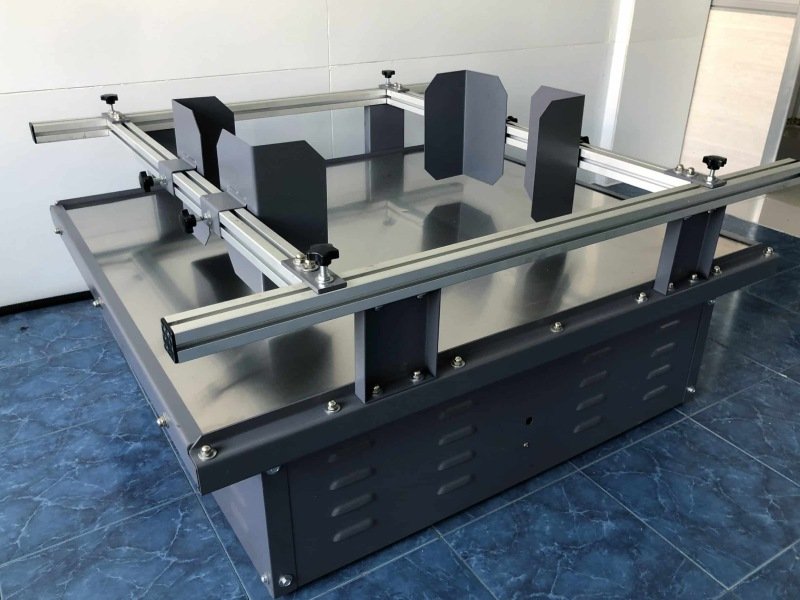Industrial hinges are essential components in a wide range of machinery, equipment, and structures, serving as pivotal connectors that enable movement, support loads, and ensure operational efficiency. When selecting hinges for industrial applications, one of the most fundamental decisions is choosing between plastic and metal materials. Both options offer distinct advantages and limitations, shaped by their physical properties, manufacturing processes, environmental resilience, and cost considerations. This article explores the key differences between industrial hinges made of plastic and metal, providing a detailed comparison to help engineers, designers, and manufacturers make informed decisions.
1. Material Composition and Properties
The primary distinction between plastic and metal hinges lies in their material composition, which directly influences their performance characteristics.
Metal Hinges
Metal hinges are typically made from materials such as steel (including stainless steel), aluminum, brass, or zinc alloys. These materials are known for their high tensile strength, durability, and ability to withstand significant mechanical stress. Steel hinges, for instance, are prized for their robustness, while stainless steel offers excellent corrosion resistance, making it ideal for harsh environments. Aluminum hinges are lightweight yet strong, and brass provides a combination of strength and aesthetic appeal. The inherent rigidity and toughness of metals allow these hinges to support heavy loads and endure repetitive motion without deforming.
Plastic Hinges
Plastic hinges, on the other hand, are manufactured from polymers such as nylon, acetal (POM), polyethylene, or reinforced composites like glass-filled nylon. These materials are generally lighter and more flexible than metals. Plastics can be engineered to exhibit specific properties, such as chemical resistance, low friction, or electrical insulation. However, they typically have lower tensile strength and are more prone to deformation under extreme loads or temperatures compared to metals. Advances in polymer technology have led to high-performance plastics that rival some metals in specific applications, but they still fall short in terms of sheer durability under heavy-duty conditions.
Key Difference: Metal hinges excel in strength and rigidity, while plastic hinges prioritize flexibility and lightweight construction.
2. Strength and Load-Bearing Capacity
One of the most critical factors in hinge selection is the ability to support weight and withstand mechanical forces.
Metal Hinges
Metal hinges are the go-to choice for applications requiring high load-bearing capacity. For example, a stainless steel hinge can support doors or panels weighing hundreds of pounds, making it suitable for industrial machinery, heavy-duty enclosures, or construction equipment. The crystalline structure of metals provides exceptional resistance to shear forces, bending, and fatigue, ensuring long-term reliability even under continuous use. This strength comes at the cost of increased weight, which may be a drawback in applications where minimizing mass is a priority.
Plastic Hinges
Plastic hinges are generally designed for lighter loads. While reinforced plastics, such as glass-filled nylon, can handle moderate stress, they are not typically suited for the same heavy-duty applications as metal hinges. For instance, a plastic hinge might be used in a lightweight cabinet or an electronic enclosure, where the load is minimal. Under excessive force, plastic hinges are more likely to crack, warp, or fail entirely, especially if subjected to prolonged stress beyond their design limits.
Key Difference: Metal hinges outperform plastic hinges in strength and load capacity, making them ideal for heavy-duty industrial uses, while plastic hinges are better suited for lighter applications.
3. Durability and Lifespan
Durability is a measure of how well a hinge withstands wear, environmental factors, and repeated use over time.
Metal Hinges
Metal hinges are renowned for their longevity. A well-maintained steel or stainless steel hinge can last decades, even in demanding conditions. Their resistance to wear and fatigue ensures they maintain structural integrity through thousands of cycles. However, metals are susceptible to corrosion unless treated (e.g., galvanized steel) or made from corrosion-resistant alloys (e.g., stainless steel). In environments with high humidity, salt exposure, or chemical presence, untreated metal hinges may degrade over time.
Plastic Hinges
Plastic hinges offer a different durability profile. While they may not match the lifespan of metal hinges under heavy mechanical stress, high-quality polymers resist corrosion, rust, and many chemicals naturally. This makes them exceptionally durable in corrosive or wet environments where metals might fail without protective coatings. However, plastics are more vulnerable to UV degradation, thermal expansion, and creep (gradual deformation under constant load), which can limit their lifespan in outdoor or high-temperature settings unless specifically engineered for such conditions.
Key Difference: Metal hinges provide superior mechanical durability and longevity under load, while plastic hinges excel in corrosion resistance but may degrade faster under UV or thermal stress.
4. Weight Considerations
Weight is a crucial factor in industries like aerospace, automotive, and portable equipment design.
Metal Hinges
Metal hinges are inherently heavier due to the density of materials like steel or brass. For example, a steel hinge might weigh several ounces or pounds, depending on its size and thickness. While this weight contributes to stability and strength, it can be a disadvantage in applications where every gram counts, such as in aircraft components or lightweight machinery.
Plastic Hinges
Plastic hinges are significantly lighter, often weighing a fraction of their metal counterparts. A nylon hinge, for instance, can provide adequate functionality for a small enclosure while adding minimal mass. This lightweight nature makes plastic hinges ideal for portable devices, consumer electronics, or any application where reducing overall weight improves efficiency or usability.
Key Difference: Plastic hinges are much lighter than metal hinges, offering advantages in weight-sensitive applications, while metal hinges provide greater stability at the expense of added mass.
5. Corrosion and Environmental Resistance
Industrial hinges often operate in challenging environments, from humid factories to outdoor installations exposed to rain and salt.
Metal Hinges
The corrosion resistance of metal hinges depends on the material and any protective treatments. Stainless steel and brass naturally resist rust and oxidation, making them suitable for marine or chemical processing environments. However, plain steel or untreated aluminum may corrode quickly without coatings like zinc plating or powder coating. Even with these treatments, prolonged exposure to harsh conditions can eventually compromise metal hinges.
Plastic Hinges
Plastic hinges have a natural advantage in corrosion resistance. Polymers like polyethylene and acetal are impervious to rust and resist many acids, bases, and solvents that would degrade metals. This makes them ideal for applications in food processing, pharmaceuticals, or chemical plants where exposure to moisture or reactive substances is common. However, plastics can degrade under UV light or extreme heat unless stabilized with additives, which may not always be sufficient for long-term outdoor use.
Key Difference: Plastic hinges are inherently corrosion-resistant and excel in wet or chemical-rich environments, while metal hinges require specific alloys or coatings to achieve similar resilience.
6. Cost and Manufacturing
Cost is a driving factor in industrial design, influencing both material selection and production methods.
Metal Hinges
Metal hinges tend to be more expensive due to the cost of raw materials (e.g., stainless steel) and the energy-intensive processes involved in their manufacture, such as forging, casting, or machining. Precision finishing, like polishing or coating, further increases costs. However, their durability and strength often justify the investment for applications where failure is not an option.
Plastic Hinges
Plastic hinges are generally more cost-effective. Polymers are less expensive than metals, and plastic hinges can be mass-produced through injection molding, a highly efficient and scalable process. This reduces both material and labor costs, making plastic hinges an economical choice for high-volume production runs or less demanding applications. However, high-performance plastics (e.g., reinforced composites) can narrow the cost gap with lower-end metals.
Key Difference: Plastic hinges are typically cheaper and easier to produce in large quantities, while metal hinges carry a higher upfront cost but offer greater long-term value in heavy-duty scenarios.
7. Temperature Tolerance
Industrial environments often involve extreme temperatures, from freezing cold to intense heat.
Metal Hinges
Metal hinges perform exceptionally well across a wide temperature range. Steel and aluminum can withstand both cryogenic conditions and high heat (up to hundreds of degrees Celsius, depending on the alloy) without losing structural integrity. This makes them suitable for ovens, refrigeration units, or engines. However, thermal expansion can affect fit and alignment in precision applications.
Plastic Hinges
Plastic hinges have more limited temperature tolerance. Most polymers soften or melt at relatively low temperatures (e.g., nylon typically withstands up to 150-200°C), and they can become brittle in extreme cold. Specialized plastics, like PTFE or PEEK, offer better heat resistance but at a higher cost. For applications requiring consistent performance in extreme temperatures, plastics are often less reliable than metals.
Key Difference: Metal hinges handle a broader temperature range effectively, while plastic hinges are constrained by narrower operational limits unless using advanced polymers.
8. Friction and Wear
The interaction between moving parts affects hinge performance and maintenance needs.
Metal Hinges
Metal hinges often require lubrication to reduce friction between moving parts, especially in high-cycle applications. Without proper maintenance, metal-on-metal contact can lead to wear, galling, or seizing. However, certain metals (e.g., brass) have naturally lower friction coefficients, and coatings like Teflon can enhance performance.
Plastic Hinges
Plastic hinges typically have lower friction coefficients than metals, especially self-lubricating polymers like acetal or nylon. This reduces wear and eliminates the need for external lubrication, lowering maintenance costs. However, under heavy loads or high speeds, plastic hinges may wear faster than metal due to their softer nature.
Key Difference: Plastic hinges offer low friction and self-lubrication, reducing maintenance, while metal hinges may require lubrication but resist wear better under intense use.
9. Aesthetic and Customization Options
Appearance and adaptability can influence hinge selection in visible or specialized applications.
Metal Hinges
Metal hinges offer a wide range of finishes, such as polished chrome, brushed nickel, or powder coating, providing a professional or industrial aesthetic. They can also be machined or forged into precise shapes, allowing for custom designs. This versatility makes them popular in architectural or high-end equipment applications.
Plastic Hinges
Plastic hinges are available in various colors through molding processes, eliminating the need for painting. However, their aesthetic appeal is often considered less premium than metal. Customization is easier and cheaper with plastics due to injection molding, but they lack the same level of precision or sophistication as machined metal hinges.
Key Difference: Metal hinges provide a premium look and precise customization, while plastic hinges offer simple, cost-effective color and shape options.
10. Applications and Industry Use Cases
The choice between plastic and metal hinges often boils down to the specific demands of the application.
Metal Hinges
- Heavy Machinery: Steel hinges secure massive doors on industrial presses or conveyor systems.
- Outdoor Equipment: Stainless steel hinges withstand weather on utility boxes or marine vessels.
- Autoteollisuus: Aluminum hinges support hoods and trunks with durability and lightweight strength.
Plastic Hinges
- Electronics: Nylon hinges connect lightweight panels in consumer devices or control boxes.
- Food Industry: Acetal hinges resist corrosion in washdown environments like processing plants.
- Furniture: Polyethylene hinges provide affordable, flexible solutions for cabinets or enclosures.
Key Difference: Metal hinges dominate in high-strength, heavy-duty applications, while plastic hinges shine in lightweight, corrosion-resistant, or cost-sensitive uses.
Päätelmä
The differences between industrial hinges made of plastic and metal are rooted in their material properties, which dictate their performance across strength, durability, weight, cost, and environmental resistance. Metal hinges, with their superior load-bearing capacity, temperature tolerance, and mechanical durability, are the preferred choice for heavy-duty, long-lasting applications in industries like manufacturing, automotive, and construction. Plastic hinges, with their lightweight design, corrosion resistance, and affordability, excel in lighter, corrosive, or cost-conscious settings, such as electronics, food processing, and consumer goods.
Ultimately, the decision between plastic and metal hinges depends on the specific requirements of the project—balancing factors like load, environment, budget, and lifespan. By understanding these differences, designers and engineers can select the optimal hinge material to ensure performance, reliability, and efficiency in their industrial applications.







